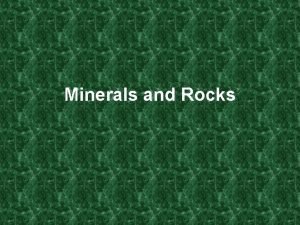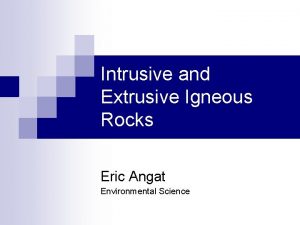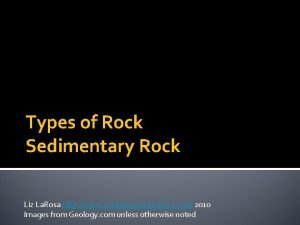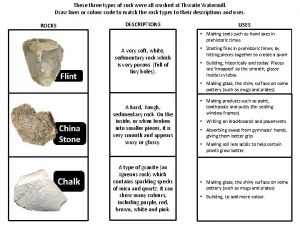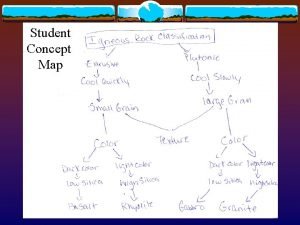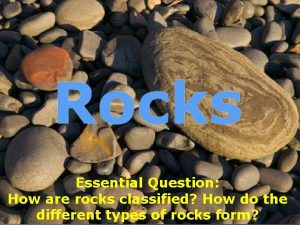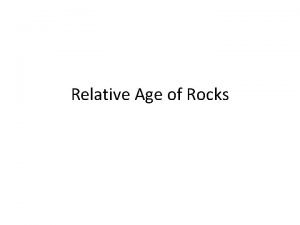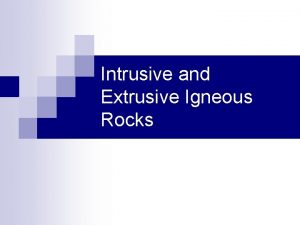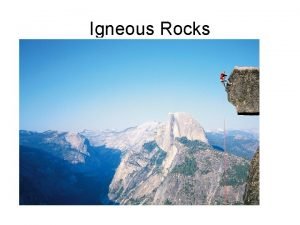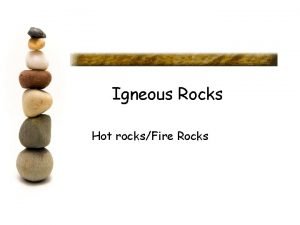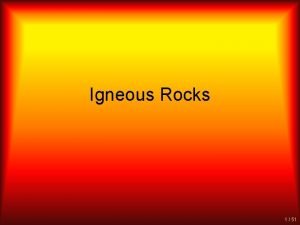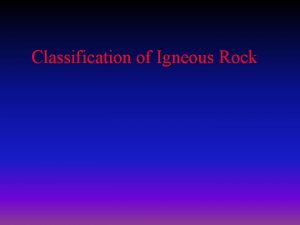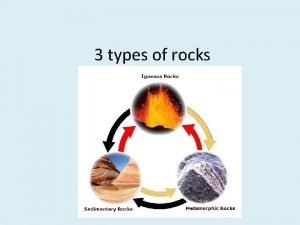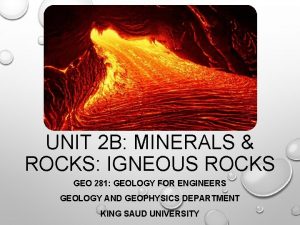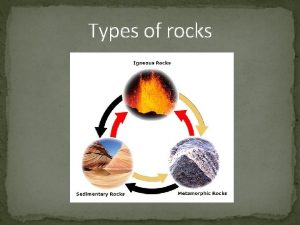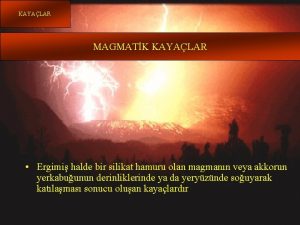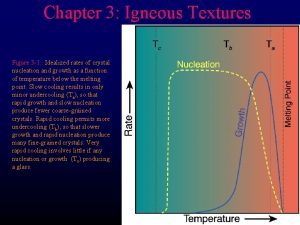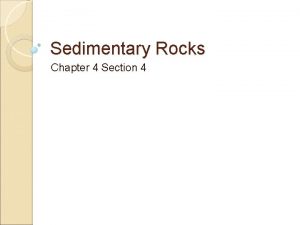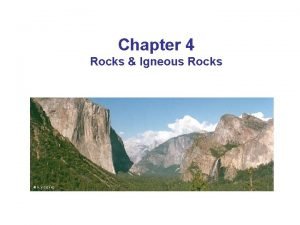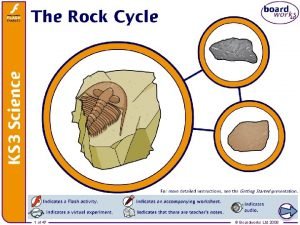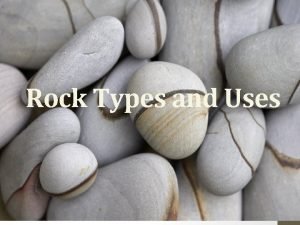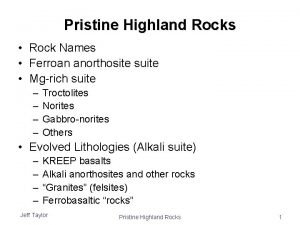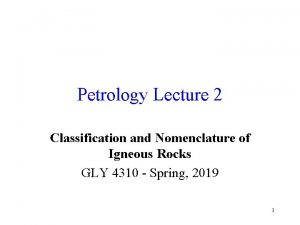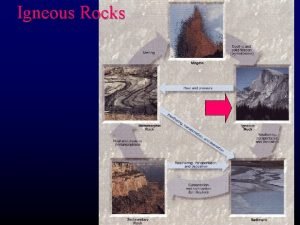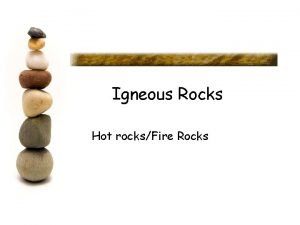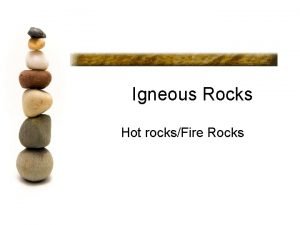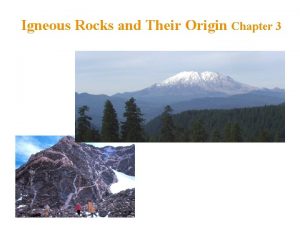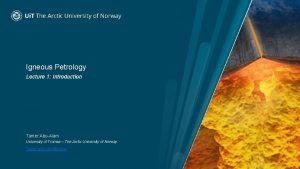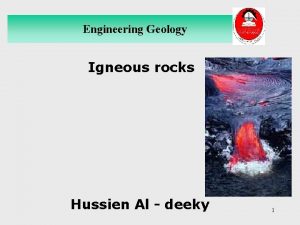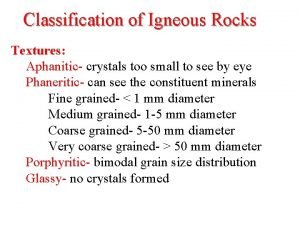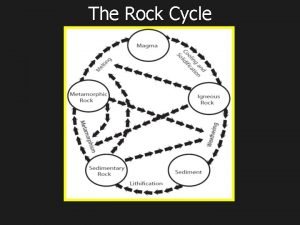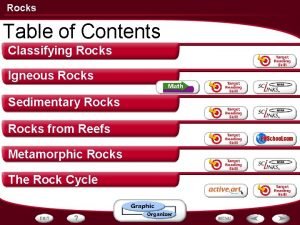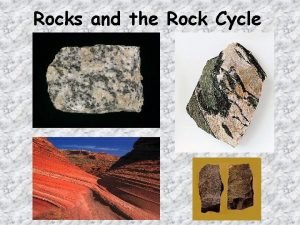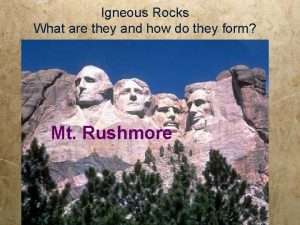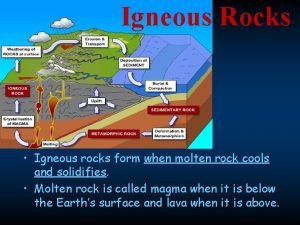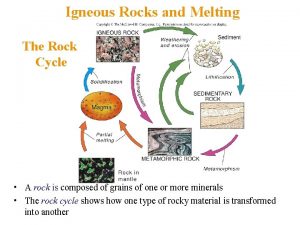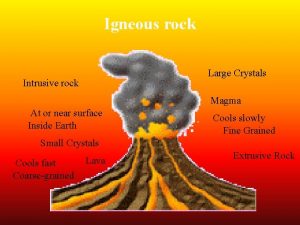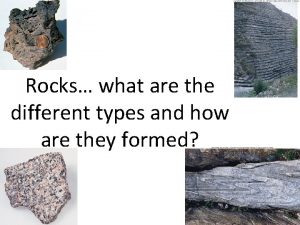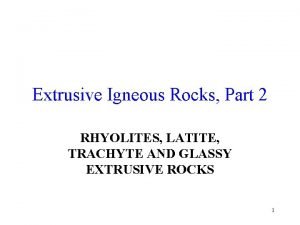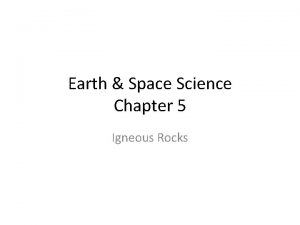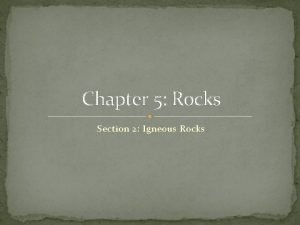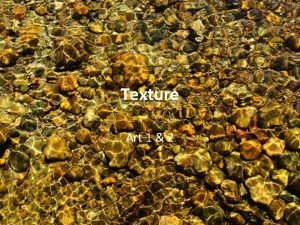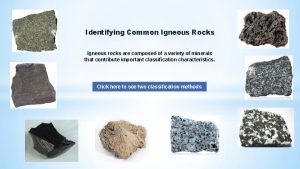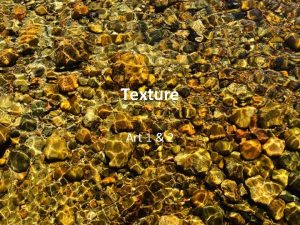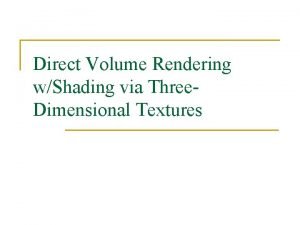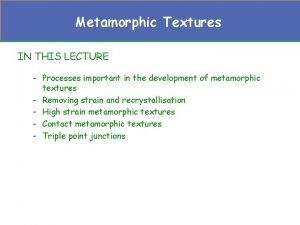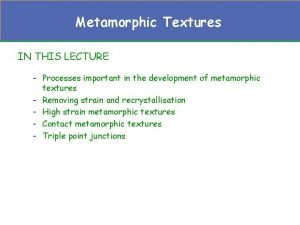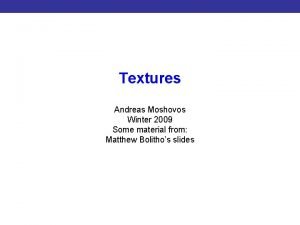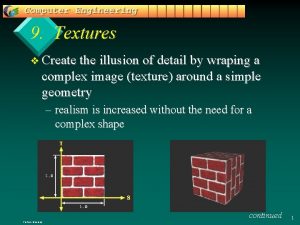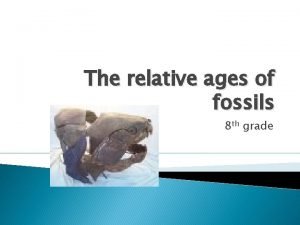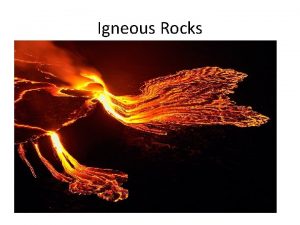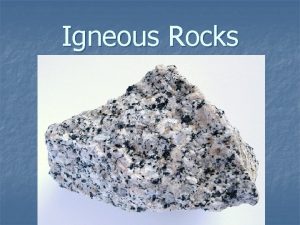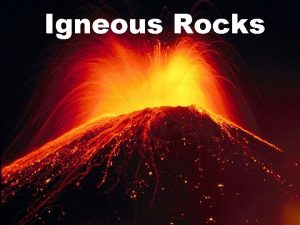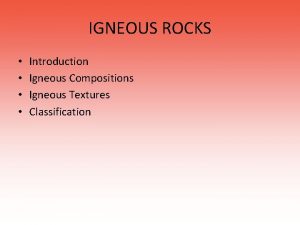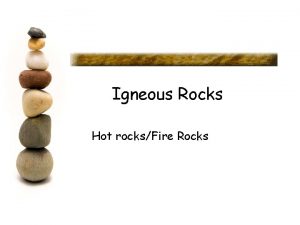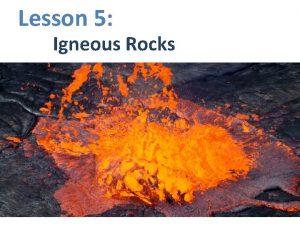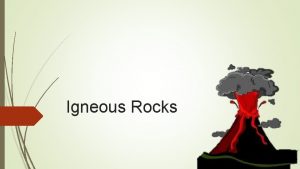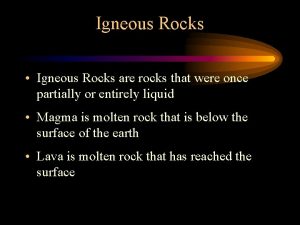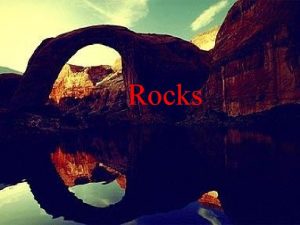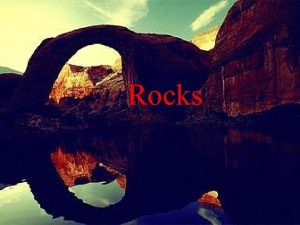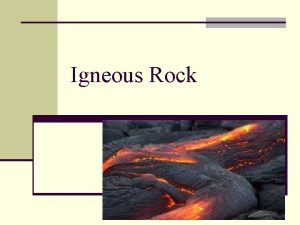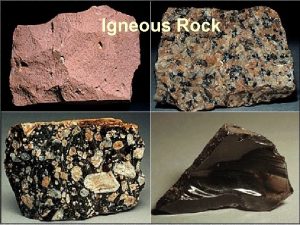Final cooling and textures of igneous rocks mostly














































































- Slides: 78

Final cooling and textures of igneous rocks (mostly plutonic)

• Growth and nucleation • Textures related to the crystallization sequence • Textures related to the chemical evolution of the magma during cooling • Textures related to deformation in a partially molten system • Textures related to sub-solidus deformation • Sub-solidus textures

1 - Growth and nucleation • Textures related to the growth rate of crystals

Nucleation and growth Many nuclei Few nuclei

• Growth and nucleation rates are a function of the degree of undercooling • Strong undercooling = Nucleation >> growth (fine texture) • Moderate undercooling = Growth >> nucleation (coarse texture)

Plutonic and volcanic textures

Glass= No crystals Groundmass= microcrystals Glass, groundmass

Porphyritic textures • 2 Grain-size populations = 2 growth events? (magma chamber & eruption)

Porphyroid textures Faster growth, or earlier crystals?

Aplites & pegmatites • Close association of (very) coarse pegmatites and (very) fine aplites Water influences both nucleation and growth rates => complex, highly variable grain size associations

A complex pegmatite body

2 - Textures related to the crystallization order

1600 1553 us Liquid id Liqu 1500 T o. C 1400 Anorthite + Liquid 1392 1300 Diopside + Liquid 1200 1274 Diopside + Anorthite Di 20 40 60 Wt. % Anorthite 80 An

Poekilitic texture Crystallization sequence Biotite > Feldspar

Simultaneous growth Classical eutectic diagram. • First minerals are either Qz or K-spar • Then, at the eutectic…

• Graphic texture: coeval growth of quartz and K-spar

Figure 3 -9. a. Granophyric quartz-alkali feldspar intergrowth at the margin of a 1 -cm dike. Golden Horn granite, WA. Width 1 mm. b. Graphic texture: a single crystal of cuneiform quartz (darker) intergrown with alkali feldspar (lighter). Laramie Range, WY. © John Winter and Prentice Hall.

3 - Textures related to the evolution of the magma during cooling

Igneous Textures Figure 3 -5. a. Compositionally zoned hornblende phenocryst with pronounced color variation visible in plane-polarized light. Field width 1 mm. b. Zoned plagioclase twinned on the carlsbad law. Andesite, Crater Lake, OR. Field width 0. 3 mm. © John Winter and Prentice Hall.

Zoned K-spar (Hercynian granite, France)

Binary diagrams with complete solid solution 1500 idus u q i L 1557 Liquid Plagioclase 1400 o T C plus Liquid Plagioclase us 1300 l id o S 1200 1118 1100 Ab 20 40 60 Weight % An 80 An The crystals formed change composition as the liquid cools (and changes its composition too)

Complex zoning A complex sequence of cryst. And magma chamber « refill »

Complex zonings Figure 3 -6. Examples of plagioclase zoning profiles determined by microprobe point traverses. a. Repeated sharp reversals attributed to magma mixing, followed by normal cooling increments. b. Smaller and irregular oscillations caused by local disequilibrium crystallization. c. Complex oscillations due to combinations of magma mixing and local disequilibrium. From Shelley (1993). Igneous and Metamorphic Rocks Under the

Plag sieving

Crystal resorption

Everything is not chemical effects!! Fast ascent can also dissolve crystals…

4 - Textures related to deformation of a partially molten system • Movements in a partially molten « mush » • Syn-plutonic deformation

Magmatic flow

Late magma movement Leucocratic magma expulsed from the cooling « mush »

« ellipsoids » , « snail structures » , « diapirs » www. earth. monash. edu. au/~weinberg

Pipes of late magmatic liquids in the mush

K-feldspar accumulation (flow segregation? )

Rheology of partially molten systems



Outcrop-scale structures Orthogneissification Shear zones with late melts C/S structures Shear zones filled with aplites and pegmatites Magmatic foliation « Proto-shear zone » Closepet granite, south India (2. 5 Ga)

Micro-structures Magmatic Sub-solidus

Quartz subgrains

Qz grain-size reduction

Continuous sequence of textures • • Feldspar alignment/accumulation Expulsion of late melts Strain partitionning on the latest melts C/S movement on weak planes (phyllosilicates) • Ductile deformation of quartz (sub-grains, etc. ) • Orthogneissification, deformation/recrystallization of all minerals

Sub-solidus evolution

• Mineral transformations • Secondary minerals • Fluids expulsion and movement – Pegmatite/aplite veins – Mineralized veins • Hydrothermal alteration – Episyenites, endoskarns, greisens – Exoskarns

Mineral transformations • Polymorphs • Exsolutions (solvus)

Phase diagram for Si. O 2

Feldspar solvus

Perthites

Opx-Cpx exsolution

Secondary minerals • « Autometamorphism »

Water-saturated solidus (granites)

Secondary minerals • Px => Amp => Bt • Px, Amp, Bt => chlorite (phyllosilicate) • K-feldspar, feldspathoids => sericite (fine white mica) • Ca-plagioclase => saussurite (epidote) • Olivine => serpentine (complex phyllosilicate), iddingsite (a mixture of various Fe-Mg silicates)

Figure 3 -20. a. Pyroxene largely replaced by hornblende. Some pyroxene remains as light areas (Pyx) in the hornblende core. Width 1 mm. b. Chlorite (green) replaces biotite (dark brown) at the rim and along cleavages. Tonalite. San Diego, CA. Width 0. 3 mm. © John Winter and Prentice Hall. Pyx Hbl Chl Bt

Sericitization K-feldspar to sericite: 3 KAl. Si 3 O 8 + 2 H+ > KAl 3 Si 3 O 10(OH)2 + 6 Si. O 2 + 2 K+

Saussuritization Dolerite from ODP leg 180 (sea of Java)

Olivine with iddingsite alteration

Calcite vein

Fluid expulsion • Typical water contents: 2 -4% in a granite • Water content of a biotite: ~2 % • Biotite: max. 5 -10 % of the rock Excess water = ? + meteoric water also feeding the hydrothermal system

Hydrothermal circulations Most of the water in hydrothermal systems comes from meteoric, surface waters (cf. O isotopes, G 214)

Effect of free, hot water • Overpressure, fractures, etc. • Very aggressive solvent! • Aplite/pegmatite veins

Pegmatites recording the same strain pattern as ductile structures Cape de Creus, Spain

Quartz solubility in hydrothermal fluids 0. 5 mol/kg water = 30 g/l 1 km 3 of pluton At 3 wt% H 2 O = 2. 7 1012 kg rock ≈ 1011 kg water Can dissolve 3 109 kg of Si. O 2, or 106 m 3 G. B. Arehart, http: //equinox. unr. edu/homepage/arehart/Courses/713/Syllabus. htm

Evidence for Si-rich hydrothermal fluids Tatio hydrothermal field, Peru

Network of pegmatites/apl ite dykes

Mineralized veins • Very incompatible elements (large ions, typically) concentrated in last liquids, then in fluids • The same elements are leached from an already cooled rock (igneous intrusion or its wall-rock) • Precipitate with hydrothermal veins

Analysis of hydrothermal fluids from inclusions in pegmatites

Gold-quartz veins • See economic geology (GEOL 344)

p. H control on solubility Changes of p. H can precipitate ore bodies: • mixing with acid groundwater • Interaction with rocks of very different chemistry (e. g. , carbonates, very mafic rocks…) G. B. Arehart, http: //equinox. unr. edu/homepage/arehart/Courses/713/Syllabus. htm

Barberton gold fields

Hydrothermal modifications of rocks • Around the intrusion – Exoskarns, etc. • In the intrusive rocks – Episyenites – Endoskarns, greisens

Around the pluton

Deposits by chemical reactions

Outside the pluton: skarn



In the pluton

p. H control on solubility High p. H helps to dissolve Si. O 2 G. B. Arehart, http: //equinox. unr. edu/homepage/arehart/Courses/713/Syllabus. htm

In the pluton Loss of quartz => « syenites » (Episyenites)

Fedlspar alteration in the pluton • K-feldspar to sericite: 3 KAl. Si 3 O 8 + 2 H+ > KAl 3 Si 3 O 10(OH)2 + 6 Si. O 2 + 2 K+ • Sericite to kaolin: 2 KAl 3 Si 3 O 10(OH)2 + 2 H+ + 3 H 20 > 3 Al 2 Si 2 O 5(OH)4 + 2 K+ Requires acidic fluids!

In the pluton • Episyenites are plutonic rocks from which the quartz has been dissolved away (therefore, they become syenites) (high p. H) • Greisens are plutonic rocks where the feldspar has been transformed into clays (kaolinite) by hydrothermal reactions (low p. H)
 Can igneous rocks form metamorphic rocks
Can igneous rocks form metamorphic rocks Igneous rock to metamorphic rock
Igneous rock to metamorphic rock Luster and streak
Luster and streak Igneous rocks
Igneous rocks Intrusive vs extrusive igneous rocks
Intrusive vs extrusive igneous rocks Rock concept map
Rock concept map How are sedimentary rocks
How are sedimentary rocks Concept map for igneous rocks
Concept map for igneous rocks What is massive igneous rock
What is massive igneous rock Three types of igneous rocks
Three types of igneous rocks Sedimentary rock concept map
Sedimentary rock concept map Non-banded grains
Non-banded grains What is reletive age
What is reletive age Pumice extrusive or intrusive
Pumice extrusive or intrusive Igneous rock
Igneous rock Pumice crystal size
Pumice crystal size How is intrusive igneous rock formed
How is intrusive igneous rock formed Igneous rock
Igneous rock What are igneous rocks made from
What are igneous rocks made from Concept map for igneous rocks
Concept map for igneous rocks Rock
Rock 3 types of rocks
3 types of rocks Igneous rock texture
Igneous rock texture Chegg
Chegg Igneous rocks
Igneous rocks Ciclo de las rocas
Ciclo de las rocas Metamorphic sedimentary
Metamorphic sedimentary Cumulophyric
Cumulophyric Sedimentary igneous rocks
Sedimentary igneous rocks Mechanical sedimentary rocks
Mechanical sedimentary rocks Cementation sedimentary rocks
Cementation sedimentary rocks Extrusive igneous rocks example
Extrusive igneous rocks example Cementation rocks
Cementation rocks Inequigranular texture igneous rocks
Inequigranular texture igneous rocks Phaneritic vs pegmatite
Phaneritic vs pegmatite Rock definition
Rock definition Igneous rock properties
Igneous rock properties Granite and pumice
Granite and pumice Igneous rocks
Igneous rocks Aphanetic
Aphanetic Igneous rocks
Igneous rocks Intrusive igneous rocks crystal size
Intrusive igneous rocks crystal size Igneous rock
Igneous rock How igneous rocks are formed
How igneous rocks are formed Gradient
Gradient How igneous rocks are formed
How igneous rocks are formed Iugs classification of igneous rocks
Iugs classification of igneous rocks Igneous rocks pronounce
Igneous rocks pronounce How are igneous rocks formed
How are igneous rocks formed Groups of sedimentary rocks
Groups of sedimentary rocks Igneous rocks
Igneous rocks Igneous rock
Igneous rock Mt rushmore rock composition
Mt rushmore rock composition Igneous
Igneous Igneous rocks
Igneous rocks Igneous rocks
Igneous rocks Magma
Magma Sedimentary deposition
Sedimentary deposition Igneous rocks
Igneous rocks Rhyolite
Rhyolite Chapter 5 igneous rocks
Chapter 5 igneous rocks Chapter 5 igneous rocks
Chapter 5 igneous rocks Andesite vs granite
Andesite vs granite Texture vocabulary
Texture vocabulary Textures drape fabric
Textures drape fabric Line color shape texture
Line color shape texture Partially resident textures
Partially resident textures Rock textures chart
Rock textures chart Simulated texture
Simulated texture Atiyeh ghoreyshi
Atiyeh ghoreyshi Rendering fur with three dimensional textures
Rendering fur with three dimensional textures Grain rotation
Grain rotation Metamorphic textures
Metamorphic textures Cuda texture memory example
Cuda texture memory example A surface that reflects a soft dull light
A surface that reflects a soft dull light Illusion textures
Illusion textures Horace morris but mostly dolores
Horace morris but mostly dolores Bus, ring and star topologies mostly used in the
Bus, ring and star topologies mostly used in the Strata are mostly found brainpop quizlet
Strata are mostly found brainpop quizlet


